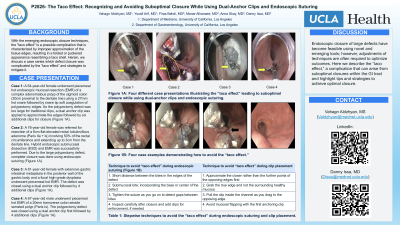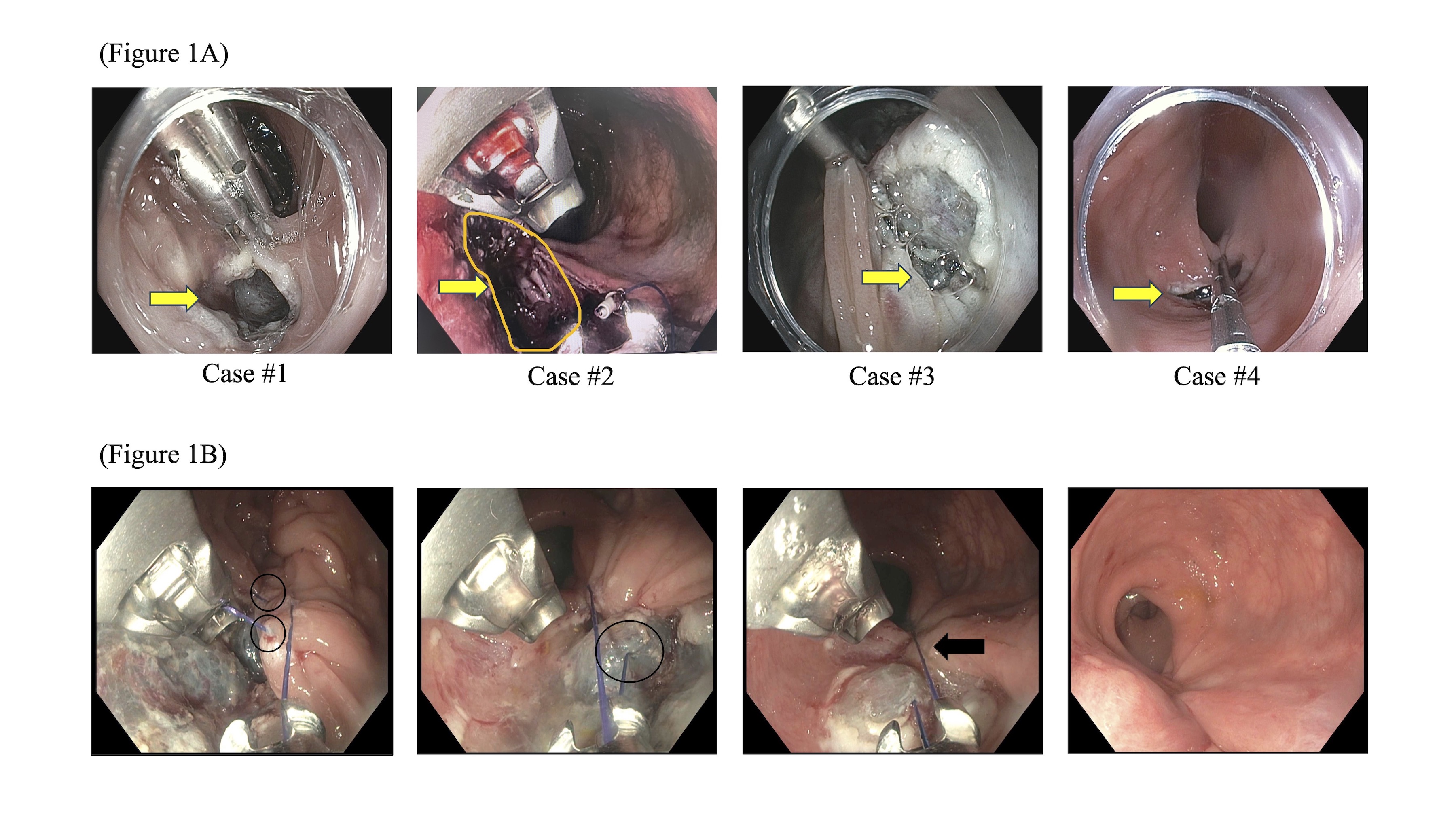Monday Poster Session
Category: Interventional Endoscopy
P2826 - The Taco Effect: Recognizing and Avoiding Suboptimal Closure While Using Dual-Anchor Clips and Endoscopic Suturing
Monday, October 28, 2024
10:30 AM - 4:00 PM ET
Location: Exhibit Hall E

Has Audio
- VA
Vahagn Aldzhyan, MS
David Geffen School of Medicine at UCLA
Los Angeles, CA
Presenting Author(s)
Vahagn Aldzhyan, MS1, Yousif Arif, MD2, Firas Bahdi, MD1, Manar Alhanaee, MD1, Anna Skay, MD3, Danny Issa, MD1
1David Geffen School of Medicine at UCLA, Los Angeles, CA; 2David Geffen School of Medicine at UCLA, Mission Viejo, CA; 3UCLA, Los Angeles, CA
Introduction: Novel endoscopic closure devices, such as the dual-anchor clip and endoscopic suturing, have been shown to be safe and effective for closing large GI tract defects following therapeutic interventions. The "Taco effect" is a phenomenon observed during the closure of large defects that can compromise the integrity of the closure and increase risks of intra-mural bleeding and need for reintervention. This phenomenon is characterized by improper approximation of the tissue edges resulting in a folded appearance resembling a taco shell.
Case Description/Methods: Case #1: A 64-year-old female with a large sigmoid polyp was referred for endoscopic mucosal resection (EMR). A submucosal injection was performed to lift the lesion from the underlying mucosa. Adequate lift was achieved, allowing for clear demarcation of the lesion. EMR was performed in a piecemeal fashion using a 27mm snare. The edges of the polypectomy site were treated with snare tip soft coagulation to ablate any possible residual polyp. The EMR defect was too large for traditional clip closure. A dual anchor clip was placed to approximate the edges, followed by six additional clips. (Figure 1A).
Case #2: A 76-year-old female was referred for resection of a large rectal tubulovillous adenoma. The polyp had flat and proximal sessile components involving 50% of the lumen. Hybrid endoscopic submucosal dissection (ESD) was performed. Due to the large mucosal resection size, complete closure was done using endoscopic suturing (Figure 1A).
Case #3: A 61-year-old female with extensive gastric intestinal metaplasia and focal low-grade dysplasia was referred for endoscopic resection. EMR was successfully performed in a piecemeal fashion. The defect was closed using a dual anchor clip first, followed by four additional clips (Figure 1A).
Case #4: A 67-year-old male was referred for resection of a large transverse colon polyp. EMR was performed using the standard technique mentioned earlier. The polypectomy defect was closed using a dual anchor clip to approximate the edges, followed by four additional clips (Figure 1A). Taco effect is shown in Figure 1A. Clues to overcome this effect are presented in Table 1.
Discussion: Endoscopic closure of large defects have become feasible using novel and emerging tools, however adjustments of techniques are often required to optimize outcomes. Here we describe the Taco effect, and highlight tips and strategies to achieve effective closure and minimize associated risks.

Note: The table for this abstract can be viewed in the ePoster Gallery section of the ACG 2024 ePoster Site or in The American Journal of Gastroenterology's abstract supplement issue, both of which will be available starting October 27, 2024.
Disclosures:
Vahagn Aldzhyan, MS1, Yousif Arif, MD2, Firas Bahdi, MD1, Manar Alhanaee, MD1, Anna Skay, MD3, Danny Issa, MD1. P2826 - The Taco Effect: Recognizing and Avoiding Suboptimal Closure While Using Dual-Anchor Clips and Endoscopic Suturing, ACG 2024 Annual Scientific Meeting Abstracts. Philadelphia, PA: American College of Gastroenterology.
1David Geffen School of Medicine at UCLA, Los Angeles, CA; 2David Geffen School of Medicine at UCLA, Mission Viejo, CA; 3UCLA, Los Angeles, CA
Introduction: Novel endoscopic closure devices, such as the dual-anchor clip and endoscopic suturing, have been shown to be safe and effective for closing large GI tract defects following therapeutic interventions. The "Taco effect" is a phenomenon observed during the closure of large defects that can compromise the integrity of the closure and increase risks of intra-mural bleeding and need for reintervention. This phenomenon is characterized by improper approximation of the tissue edges resulting in a folded appearance resembling a taco shell.
Case Description/Methods: Case #1: A 64-year-old female with a large sigmoid polyp was referred for endoscopic mucosal resection (EMR). A submucosal injection was performed to lift the lesion from the underlying mucosa. Adequate lift was achieved, allowing for clear demarcation of the lesion. EMR was performed in a piecemeal fashion using a 27mm snare. The edges of the polypectomy site were treated with snare tip soft coagulation to ablate any possible residual polyp. The EMR defect was too large for traditional clip closure. A dual anchor clip was placed to approximate the edges, followed by six additional clips. (Figure 1A).
Case #2: A 76-year-old female was referred for resection of a large rectal tubulovillous adenoma. The polyp had flat and proximal sessile components involving 50% of the lumen. Hybrid endoscopic submucosal dissection (ESD) was performed. Due to the large mucosal resection size, complete closure was done using endoscopic suturing (Figure 1A).
Case #3: A 61-year-old female with extensive gastric intestinal metaplasia and focal low-grade dysplasia was referred for endoscopic resection. EMR was successfully performed in a piecemeal fashion. The defect was closed using a dual anchor clip first, followed by four additional clips (Figure 1A).
Case #4: A 67-year-old male was referred for resection of a large transverse colon polyp. EMR was performed using the standard technique mentioned earlier. The polypectomy defect was closed using a dual anchor clip to approximate the edges, followed by four additional clips (Figure 1A). Taco effect is shown in Figure 1A. Clues to overcome this effect are presented in Table 1.
Discussion: Endoscopic closure of large defects have become feasible using novel and emerging tools, however adjustments of techniques are often required to optimize outcomes. Here we describe the Taco effect, and highlight tips and strategies to achieve effective closure and minimize associated risks.

Figure: Figure 1A: Here are four different case examples illustrating the "taco effect" leading to suboptimal closure while using dual-anchor clips and endoscopic suturing. Figure 1B: In contrast, here we present four case examples where we demonstrate our technique to avoid the "taco effect" during endoscopic suturing.
Note: The table for this abstract can be viewed in the ePoster Gallery section of the ACG 2024 ePoster Site or in The American Journal of Gastroenterology's abstract supplement issue, both of which will be available starting October 27, 2024.
Disclosures:
Vahagn Aldzhyan indicated no relevant financial relationships.
Yousif Arif indicated no relevant financial relationships.
Firas Bahdi indicated no relevant financial relationships.
Manar Alhanaee indicated no relevant financial relationships.
Anna Skay indicated no relevant financial relationships.
Danny Issa: Boston Scientific – Consultant, Speakers Bureau. Eli Lilly – Speakers Bureau.
Vahagn Aldzhyan, MS1, Yousif Arif, MD2, Firas Bahdi, MD1, Manar Alhanaee, MD1, Anna Skay, MD3, Danny Issa, MD1. P2826 - The Taco Effect: Recognizing and Avoiding Suboptimal Closure While Using Dual-Anchor Clips and Endoscopic Suturing, ACG 2024 Annual Scientific Meeting Abstracts. Philadelphia, PA: American College of Gastroenterology.
